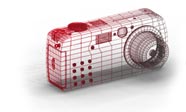 |
|
||
|
|
|
Main / Photography GlossaryA | B | C | D | E | F | G | H | I | J | K | L | M | N | O | P | Q | R | S | T | U | V | W | X | Y | Z R3000 Chemical process for making prints from slides. RA4 Process that producing slides from negatives. Rangefinder Instrument for measuring distances from a given point, usually based on slightly separated views of the scene provided by mirrors or prisms. May be built into non-reflex cameras. Single-lens reflexes may have prismatic rangefinders built into their focusing screens. The Leica and the Contax G2 still keep the flag up in this areas. Rear-Curtain Sync: Flash fires an instant before the second (rear) curtain of the focal plane shutter begins to move. When slow shutter speeds are used, this feature can create a blur effect from the ambient light, i.e., a flowing- light patterns following a moving subject with subject movement frozen at the end of the light flow. (See "Front-Curtain Sync".) Most mid range and top flight auto camera models have this feature. Refractive index A technical term used to describe the effect of a lens in causing light rays to bend; important aspect in lens design. Reflector Any device used to reflect light onto a subject to improve balance of exposure (contrast). Another way is to use fill in flash. Relative aperture. Numerical expression of effective aperture, also known as f-number. Obtained by dividing focal length by diameter of effective aperture. Release-Priority : For autofocus, shutter can be released anytime (i.e., even when subject is not in focus). Helps you avoid missed opportunities when you are not concerned with absolute focusing precision, terms apply primarily for Nikon. Reciprocity Most films are designed to be exposed within a certain range of exposure times-usually between 1/15 second to 1/1000 second. When exposure times fall outside of this range-becoming either significantly longer or shorter-a film's characteristics may change. Loss of effective film speed, contrast changes, and (with color films) color shifts are the three common results. These changes are called reciprocity effect. Generally, as a quick reference, exposure beyond one second needs to compensate for this characteristic of film. Resolution The ability of a lens to discern small detail; in photography, the image resolution in the final photograph depends on the resolving power of the sensitive emulsion and on that of the lensóthe two are not related, but the effective resolution is a function of both; for reasonably accurate photographic measurements of lens resolution, the sensitive material must therefore have a much greater resolving power than the lens. Reticulation Cracking or distorting of the emulsion during processing, usually caused by wide temperature or chemical-activity differences between the solutions. Reproduction ratio Term used in macrophotography to indicate the magnification of a subject; specifically the size of the imag recorded on film divided by the actual size of the subject; for example, if the image on film is the same size as the subject, the reproduction ratio is written as 1:1 or 1X Retouching Altering a print or negative after development by use of dyes or pencils to alter tones of highlights, shadows, and other details, or to remove blemishes. Retrofocus Design In a retrofocus design, which is advantageously applied to wideangle lenses, the back focus is designed longer than the lens' focal length to allow clearance for the movement of the reflex-mirror (No Mirror Lock up or seperate viewing accesory attachment is required). It consists of front diverging apd rear converging lens groups, as opposed to the telephoto design, and is therefore also called the inverted telephoto design. RGB The red, green & blue, the black is simulated colour. CMYK is the four primary colours. RTS Contax's term for Real time system. |
| � Copyright 2025 ShutterMag.com All Rights Reserved. |
